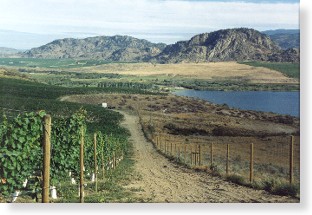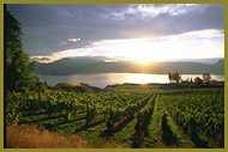 |
|
|
|
British Columbia Wine Country
Between the Cascade Mountains to the west and the Monashee Mountains
to the east, the beautiful
Okanagan Valley stretches north 155 miles from from the
desert-like region of Osoyoos - adjacent to the Washington State
border - to Tappen in the recreation paradise of the South Shuswap; the
Similkameen Valley is also a desert-like region, slightly higher in
elevation, that heads northwest along Highway 3 from Osoyoos to the historic
The higher-elevation Similkameen Valley now holds 11 wineries (as of April, 2010). It is known for its western frontier history of gold mining and ranching. Due to the high mountains on both sides of the valley, and the storage and reflective qualities of their rocks, the day's heat is held in the valley long after sun set. Even so, the Similkameen can be colder in winter than the Okanagan Valley because of the absence of a major body of water to moderate temperatures.
The arid, desert-like grasslands of the Similkameen Valley's floor are bordered on one side by rich marshes and moist woodlands of cottonwood and birch and on the other side by towering cliffs, bench lands and hillsides covered with ponderosa pine forests. Dry, persistent winds reduce moisture in vines and soil and help keep vineyards disease free; irrigation is a necessity.
The eastern end of
the Similkameen Valley terminates on the desert floor of the
southern Okanagan Valley appellation. A chain of clear,
blue lakes -- created, connected and fed by rivers -- runs the
north/south course of the long Okanagan Valley, stirring the searing
summer-air masses in the south and the frigid winter air in the
north. Clusters of
wineries (more than 100) and vineyards throughout the
Okanagan depend on these water-stirred air currents to moderate
local and varying climate extremes.
Use our Winery & Merchant Finder to locate
addresses and
The Okanagan Valley is British Columbia's oldest and main grape-growing region. Although it lies on the same latitude as the northern German and French vineyards, the Okanagan Valley is not all classified as a "cool-climate" growing region. Distinct microclimates occur throughout the Valley, from the hot, sandy, desert soils in the southern valley to the cooler vineyard sites in the north, with their deep topsoil and clay. Chardonnay, Merlot, Cabernet Sauvignon, Pinot Gris and Pinot noir grow in the south, while Pinot blanc, Pinot noir, Pinot gris, Riesling, and Gewürztraminer are grown in the mid and northern regions, some left to freeze on the vine for the region's famed Icewines.
Diversity within BC's Okanagan/Similkameen wine regions goes well beyond variable microclimates and grape varieties. Wine styles also vary broadly throughout the valleys, as do the nationalities of their winemakers. Look for wine styles reminiscent of those found in Germany, Austria, France, Italy, Switzerland, Australia, New Zealand and South Africa. Winemakers within this multi-ethnic winemaking region often pay homage to the wine styles of their homelands.
The British Columbia wine industry was reborn in the late 1980s when many
cool-climate, hybrid grape varieties were uprooted and replaced with
vinifera
The nature of Okanagan Valley wine making was dramatically changed, particularly in the area south of McIntyre Ridge in the Southern Okanagan Valley, where 50% of BC's wine grapes now grow. Today, fine red varieties, as well as whites, have taken hold in the beautiful and agriculturally protected South Okanagan region. Less than 10 inches of annual rainfall are typical here since this region falls within the northernmost extension of the Sonora Desert -- a desert that shares its influence with both the Okanagan and eastern Washington wine regions.
To fully appreciate the diversity of the Okanagan's wine-growing climates and styles, plan to follow the crush on one of your trips to the region. Begin in the southern end of the Valley (see map), where grape harvest begins as much as three weeks earlier than in the north. Continue traveling north (and/or northwest to take in Similkameen Valley wine country) and notice the cooling temperatures as you travel north. Correspondingly, the further north you travel, the later the harvest times. Grapes ripen more slowly in the north, and wine grapes turn to cool-climate varietals.
If you are not able or choose not to visit the Okanagan during the harvest season, it's still a good idea to start your tour in the southern region, during the cooler part of the day. You can visit the more rural wineries located in the richly agricultural and rural southern region during the morning hours, and travel north through the valley to complete your tour.
Many fine bed and breakfast lodging choices are located near wineries, or you can find many fine Osoyoos hotels in the most southern part of the Valley, just north of the Washington border of the United States. |
|
Copyright © 1999 -
October, 2019 Susan R. O'Hara. All
rights reserved. |
|






 town of Princeton some 60 miles away. Both
appellations are known for the large variety of wine grapes grown in
multiple micro climates.
town of Princeton some 60 miles away. Both
appellations are known for the large variety of wine grapes grown in
multiple micro climates. wine
grapes which now thrive in selected microclimates along Lakes Okanagan,
Skaha and Osoyoos and as far north as just above the 50th latitude. As
a result of this bold government-subsidized "pull-out program," 90% of the
hybrid-grape vineyards in the Okanagan Valley were removed, setting the
stage for plantings of vinifera grapes.
wine
grapes which now thrive in selected microclimates along Lakes Okanagan,
Skaha and Osoyoos and as far north as just above the 50th latitude. As
a result of this bold government-subsidized "pull-out program," 90% of the
hybrid-grape vineyards in the Okanagan Valley were removed, setting the
stage for plantings of vinifera grapes.

